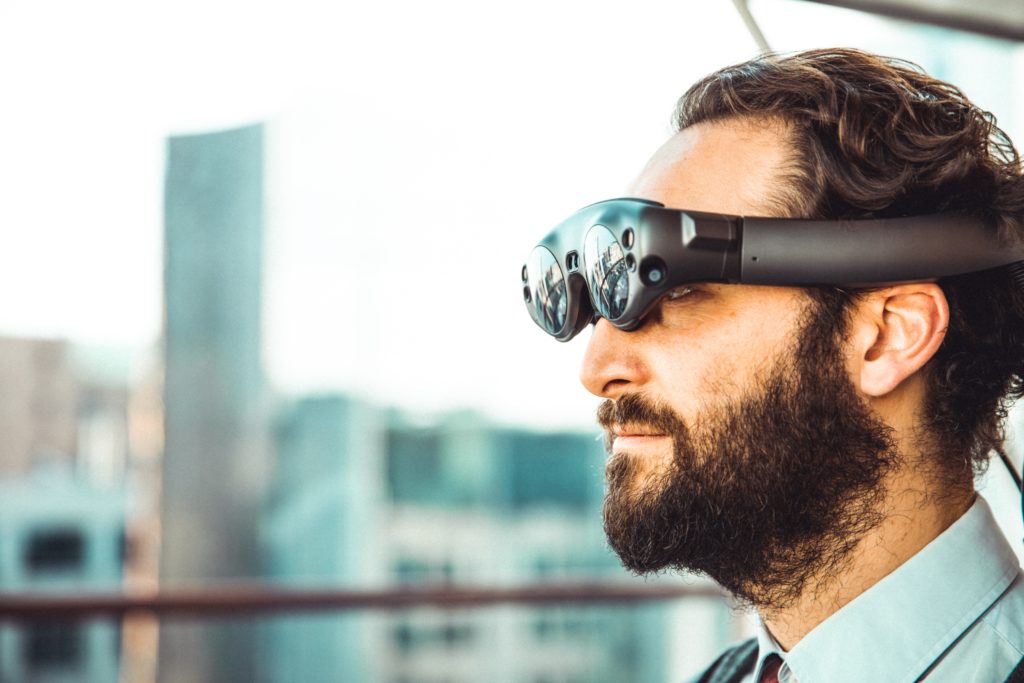Smart Glasses: A Take on Augmented Reality Technology from an Ex-Explorer
When smart glasses hit the market a decade ago, this newest wave of technology was supposed to be the future, directing our view away from our phones and into the present. But 11 years and 15 iterations later, smart glasses remain an interesting idea but have not turned into practical reality. What gives?
To really understand smart glasses, we have to go back to the beginning.
A Brief History of Google Glass
It’s 2011. Katy Perry’s single “Firework” is inescapable, Bridesmaids hit the theaters, and Rebecca Black exploded out of nowhere thanks to her sleeper hit song “Friday.” Nearly 85% of Americans are now using mobile devices, sporting the latest iPhone 4s and the Samsung Galaxy Nexus. And we’re not just using smartphones for calls and text – 29% of Americans use their phones to stream music, up 66% from 2010, and 14% watch videos on their phones (source: CNN). Smart devices are hitting the market, such as the Fitbit and Nest, the first learning thermostat. In the background, Google is furiously developing the first-ever smart glass prototype they cleverly name… drumroll, please… Google Glass.
Fast forward to 2013, and Google debuts Google Glass (Glass) for consumer use. Glass is a futuristic pair of glasses, without the lens, but with a “heads-up” digitally projected display, video camera, and even Bluetooth connection. Lighter than a pair of standard Ray-Bans, Google promises that Glass is a “wearable computer” that becomes an extension of your mind and allows for “hands-free work.” Gone are the days of hunched, huddled masses, glued to their phones, missing out on the world around them. Glass promises a brighter, more connected future with the simple phrase: “OK, Google.”
With Glass’ debut, Google announced a contest on Twitter to round out their group of beta testers, called Glass Explorers, asking people to Tweet and post on Google+ (rest in peace) what they would do #IfIHadGlass. Magically, Google chooses me as one of the many Glass Explorers. The world feels bright, technology is on an exciting new trajectory, and the possibilities are endless.
Why was Google Glass, and smart glasses in general, a failure?
Google Glass did not change the world and is considered by the tech industry to be a flop. The clunky design, short battery life, high price tag, and spotty connectivity certainly all contributed to its failure. But other more nebulous factors had a bigger role to play.
The primary factor? Google Glass had no clear purpose and didn’t solve a pressing problem. Do you use it to look cool? No, because it was decidedly NOT cool (Google “Glasshole” for proof). Is it to help you answer texts and emails more efficiently so you can be more present? Sure, but in my experience, it took way longer to answer an email via Glass than it did on my phone. Does Glass help you capture pictures and videos? This one was true, but the quality was nowhere near that of a phone camera and sharing was not as easy as it seemed. All in all, Google Glass didn’t really do anything for the end user.
Then, there were the privacy concerns. Let’s remember that smartphones, live streaming, and posting every aspect of our lives weren’t as common in 2013 as it is today. People were concerned about Glass Explorers being able to record or photograph anyone without their knowledge or consent. While these concerns may seem a little silly now, it was a serious publicity issue for Google Glass at the time.
Is Google Glass still a thing? What is Google Glass used for today?
Despite all these issues, Google Glass still exists today. While the Explorer Edition of Google Glass has long been off the market, Google released an updated business-to-business (B2B) version, the Enterprise Edition, in 2017. This newer model of Google Glass is used in enterprise organization settings, such as in construction and medical jobs where the hands-free function of Glass can increase productivity. This pivot made sense. While a regular person answering texts in the sky may never catch on, live streaming your visual perspective to get a second opinion for a patient or to showcase a product feature to investors in another state through Glass’ camera is an excellent use of this technology.
AR: The Future of Smart Glasses
Since Google Glass came out in 2013, more than a dozen other smart glasses have hit the market, like the 2016 Snap Spectacles that… also flopped. (Hey, at least they looked good!) And more recent versions of smart glasses are starting to steer away from the photo- and video-capturing aspect of the earlier versions to instead focus on the augmented reality (AR) aspect of their functionality.
What is AR?
AR is simply any device that enhances reality with digital overlays, such as Glass’ digitally projected display. AR is different from VR, or virtual reality, which endeavors to use immersive visual, audio, and even touch-related simulations to transport users to another world entirely. Instead, AR keeps the user in the real world, but with additions or augmentations. The general public is already familiar with AR at this point.
The marketing industry has seen brands’ adoption of AR skyrocket as consumers jumped at the chance to try out products virtually. Examples of this are hidden in plain sight, such as Wayfair’s app that allows someone to “place” an object, such as an armchair, in their space through the user’s smartphone camera. And Sherwin Williams, which uses AR to enable its app users to try new paint colors out on their wall without any actual paint at all. Even Pokémon Go is an excellent example of AR — a game that blends fictional digital characters with real-life environments.
And AR devices are seeing a surge in demand. Search interest in “smart glasses,” including AR, reached an all-time high in September 2021 after Facebook announced Ray-Ban Stories and interest remains high. Smart AR glasses revenue is projected to reach about $19.7 billion in the US in 2022 alone, creeping up to rival the uber-popular smartwatch category which will reach $22.6 billion. Gaming is driving AR forward, with a whole community eager to be immersed in their games but less eager to spend the money required to purchase expensive VR headsets. And Meta’s Metaverse, a hot topic in tech and marketing, can be accessed by AR devices. With all of this in mind, glasses may be a more pragmatic and affordable option for the general public to access the virtual world beyond their smartphone.
Meta and their AR glasses
Since Facebook’s rebrand to Meta, there’s been a renewed interest in AR that extends to AR glasses. In September of 2021, Meta announced their partnership with Ray-Ban to produce Ray-Ban Stories. Ray-Ban Stories solve the clunky style issues that plagued Glass, but with microphone, speakers, and camera built in the glasses still focus on the photo- and video-capturing and sharing aspect rather than AR.
Meta was not content to leave AR out of their smart glasses foray, and in April of 2022 they announced their plan to launch two versions of AR glasses by 2024, with additional versions rolling out every other year. Meta’s AR glasses, called Project Nazare, will not be using a phone for computing, but will instead connect to a separate device. Their more affordable glasses, currently codenamed Hypernova, will be more like Glass and feature heads-up display. According to a report by The Verge, Meta will pair both AR glasses with a wearable device that allows you to control the glasses with your mind, using the process of electromyography (EMG). If Meta can make this capability functional, wearable, and affordable they would set themselves apart from competing companies like Apple, also looking to join the AR glasses world.
Apple is also eager to join the fray with their promised Apple Glasses. While there is precious little to report on right now, it appears that Apple is venturing further into the AR arena with their Glasses, adding an AR headset to the mix.
The verdict: Are smart glasses our generation’s jet pack or light bulb?
Smart glasses have always leveraged AR. But the recent focus on AR technology is better suited to answer the “What will this do for me?” question that the first version of Google Glass failed to address. Smart glasses are truly a situational device, rather than an always-on device like smart watches. Companies need to focus on the situational, practical applications of these devices to galvanize the public.
Several of the big tech giants are now heavily invested in AR glasses. Meta’s push to make the metaverse the next big thing hinges on adoption of AR technology. And while it’s too early to comment on how Apple will compete with Meta’s AR glasses, with both tech giants playing in the same space it’s clear that the time for AR is now. Marketers should keep an eye on how they can slowly test into AR, from apps that showcase products in real time like Sherwin Williams to watching for AR advertising opportunities as AR devices hit the market.
Google Glass was a flop because it wasn’t easy to use or helpful. I spent more time charging it and figuring out how to access my contacts than anything else. But if future smart glass communication can highlight situations when the AR is helpful, like on a job to produce measurements of a part, or at a game to flash player data, or at even the more traditional features like livestreaming a child’s recital to family members. If smart glasses can be stylish, which the Ray-Ban Stories proved is possible. If smart glasses can have seamless integration into existing platforms and software. Then, and only then, will I welcome smart glasses into my arsenal of gadgets.




